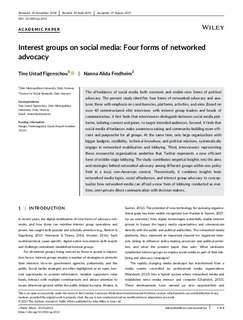| dc.description.abstract | The affordances of social media both constrain and enable new forms of political advocacy. The present study identifies four forms of networked advocacy and analyses these with emphasis on constituencies, platforms, activities, and aims. Based on over 40 semistructured elite interviews with interest group leaders and heads of communication, it first finds that interviewees distinguish between social media platforms, tailoring content and genre, to target intended audiences. Second, it finds that social media affordances make awareness‐raising and community‐building more efficient and purposeful for all groups. At the same time, only large organizations with bigger budgets, credibility, technical knowhow, and political relations, systematically engage in networked mobilization and lobbying. Third, interviewees representing these resourceful organizations underline that Twitter represents a new efficient form of middle‐stage lobbying. The study contributes empirical insights into the aims and strategies behind networked advocacy among different groups within one policy field in a local, non‐American context. Theoretically, it combines insights from networked media logics, social affordances, and interest group advocacy to conceptualize how networked media can afford a new form of lobbying conducted as real‐time, semi‐private direct communication with decision makers. | |
